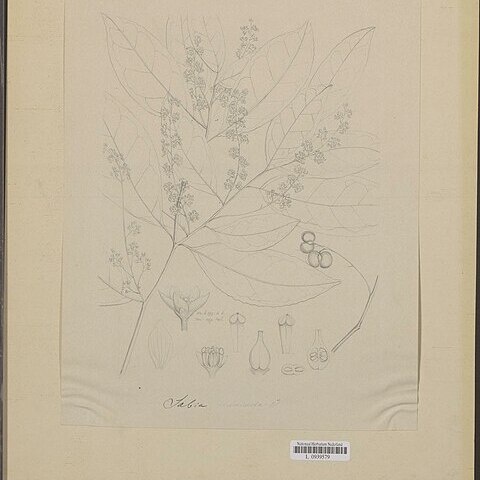Evergreen or deciduous, woody climbers or more or less scandent shrubs (rarely recorded as small trees). Twigs terete, striate (see note), with ± prominent leaf cushions, unarmed, mainly in deciduous species with some cataphylls at their base, spirally arranged. Buds either ± globular and obtuse to rounded, or ovoid and acute; scales glabrous to pubescent, ciliolate or not, persistent at the base of the twigs. Leaves simple, ovate or elliptic to lanceolate, 2-25 by 1-10 cm, herbaceous to coriaceous, petioled, entire or very rarely subentire; nerves 3-12 pairs, ascending to patent, curved to straight. Flowers bisexual, 5-merous, actinomorphic, up to c. 15 mm diam., green to white, yellow, or purple, axillary, either solitary, or arranged in a few-to many-flowered cyme, appearing before or with the new leaves. Cymes axillary, either solitary, or, when the subtending leaves are shed or are bract-like, arranged in racemose to thyr-soid or sometimes corymbose inflorescence, pedicel ± thickened upwards in fruit; bracts ovate to lanceolate, up to 6 mm, bracteoles as bracts but usually smaller, or sepal-like, or minute and then often situated near calyx. Sepals 5(-7, see bracteoles), equal to very unequal mutually, mostly ± confluent at the base, variable in size and shape but often suborbicular or broad-ovate to ovate, persistent. Petals 5, rarely 6 or 7, episepalous, imbricate, suborbicular to lanceolate, glabrous, sometimes (sub)ciliolate, persistent OR Not; nerves ± parallel,branching or not, sometimes conspicuous when dark-coloured. Stamens 5, epipeta-lous, ± equal, persistent or not; filaments more or less flattened, adherent to the base of the subtending petals; anthers globular to ellipsoid, introrse, upright or inflexed. Disk in most species ± crown-shaped, sometimes short-cylindrical (S. sumatrana), truncated conical, or ± cushion-shaped; lobes and ribs, if present, alternating with the stamens. Pistil: style conical to cylindrical, rarely absent, persistent. Ovary superior, 2-celled, (sub)globose to subreniform, usually laterally somewhat compressed, very rarely subapocarpous. Ovules 2 per cell, more or less superimposed, attached to the septum, hemi-anatropous. 'Drupelets' 1-seeded or very rarely with 2 seeds, (sub)globose, obovoid, oblong-obovoid (or pyriform), or subreniform, laterally ± compressed, green or white to red or deep blue when fresh; mesocarp rather thin, pulpy, sometimes with many dark 'granules', endocarp crustaceous, very often with ± prominent ribs forming a fine to coarse reticulate pattern, margin sometimes distinctly keeled. Seed conform to the drupelet; testa usually conspicuously dark-dotted, inside often lined with a very thin layer of endosperm. Embryo with two flat, smooth, somewhat undulated, or sometimes strongly folded cotyledons and a cylindrical rootlet curving to the hilum.
More
Woody climbers or scandent shrubs, sometimes suberect, rarely erect, deciduous or evergreen. Branches terete or flexuose, striate, pubescent or glabrous, unarmed (except S. japonica); branchlets with bud scales persistent at bases, pubescent or glabrous. Leaves simple, glabrous or slightly pubescent, margins mostly entire or sometimes minutely erose, but never toothed, mostly narrowly cartilaginous and revolute. Flowers bisexual, rarely polygamous, axillary, solitary, or few and arranged in cymes or subumbellate panicles, actinomorphic. Sepals (4 or)5[-7], persistent, imbricate, green, white, yellow, or purple. Petals usually (4 or)5(or 6)[or 7], persistent or not, longer than sepals. Stamens (4 or)5(or 6), all fertile; filaments ± flattened, adherent to bases of petals; anthers introrse or extrorse, upright or inflexed. Carpels 2; styles 2, persistent, connate; ovules 2 per carpel, ± superimposed, half-anatropous. Fruit a schizocarp, with 2 drupelets, usually 1 developed, drupelet laterally compressed; mesocarp white, reddish, or blue, rather thin, fleshy; endocarp crustaceous, with prominent veins forming a reticulate pattern (foveolate). Seed 1[or 2], subreniform; testa leathery, dotted; embryo with 2 undulate, or strongly folded cotyledons, radicle curved.

